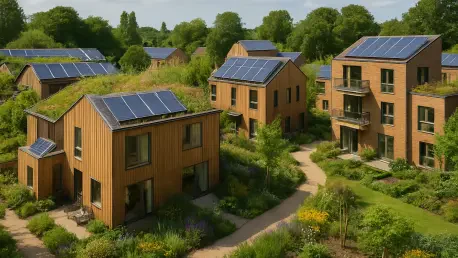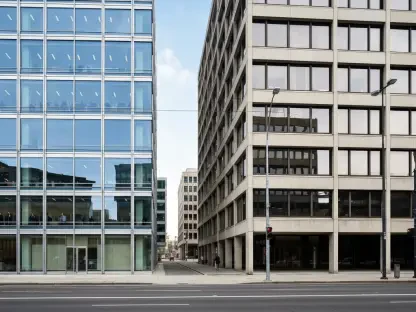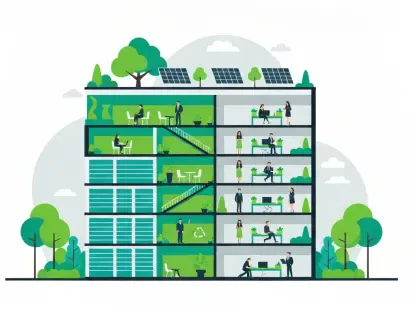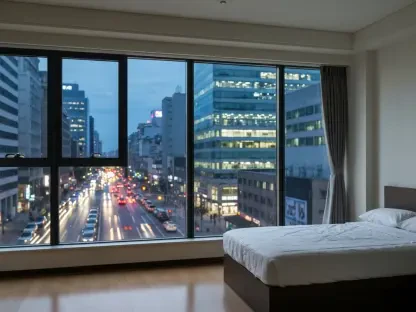Imagine a once-forgotten stretch of land along Liverpool’s Mersey waterfront, previously a landfill, now on the cusp of becoming a beacon of sustainable urban living. The Festival Gardens housing scheme, spanning 27 acres, represents a bold vision to transform this brownfield site into a thriving neighborhood that could reshape how cities approach development. Led by Liverpool City Council in partnership with Urban Splash and igloo Regeneration, the project aims to deliver up to 800 homes across three phases, with the initial phase targeting 440 homes by late 2026. Far from being just another housing estate, this initiative seeks to create a multi-generational, eco-friendly community that balances innovative design with historical reverence for the 1984 International Garden Festival legacy. As urban centers grapple with housing shortages and environmental challenges, this ambitious plan raises a compelling question: could this development set a new benchmark for what sustainable living looks like?
The scope of the project extends beyond mere construction, focusing on diversity and inclusivity to meet a wide array of needs. With 34 distinct building styles, the neighborhood will cater to families, retirees, and those seeking affordable or alternative living arrangements like co-housing. The first phase alone includes 80 extra care units and 110 affordable homes, surpassing the Council’s 20% affordability target. This variety ensures that the area will foster a mixed community where residents at different life stages can thrive together. Moreover, the integration of high-quality public spaces, including a newly established 37-acre park—Liverpool’s first of the 21st century—highlights the commitment to creating a sense of place. Achieved through recycling over 95% of excavated materials, this transformation from wasteland to vibrant hub underscores a dedication to both environmental and social responsibility, setting the stage for a neighborhood that prioritizes connection and well-being.
Sustainability as the Cornerstone
Eco-Friendly Innovation
At the core of the Festival Gardens development lies an unwavering commitment to environmental stewardship, aiming to minimize ecological impact through forward-thinking strategies. Developers are prioritizing renewable energy sources and advanced construction techniques to significantly reduce the carbon footprint of the neighborhood. This focus aligns seamlessly with regional and national objectives to create greener urban spaces, positioning the project as a potential model for other cities to emulate. By embedding sustainability into every facet of planning—from material selection to energy systems—the initiative seeks to demonstrate that large-scale housing can coexist with ecological responsibility. If successful, this approach could influence future developments across the UK, proving that urban growth need not come at the expense of the planet. The emphasis on cutting-edge methods also reflects a broader shift in the construction industry toward more sustainable practices, making this project a timely experiment in eco-conscious design.
The drive for sustainability in Festival Gardens is not just about meeting current standards but about pushing boundaries to set new ones for urban planning. Beyond energy efficiency, the project incorporates thoughtful infrastructure to support a growing population without straining local resources. Community facilities are being designed with long-term environmental impact in mind, ensuring that public spaces remain functional and green for decades to come. This holistic approach also considers the integration of transport solutions that encourage low-carbon options, such as cycling paths and pedestrian-friendly layouts. By tackling these elements head-on, the development aims to create a self-sustaining ecosystem where residents can live with minimal environmental disruption. This ambitious vision could serve as a blueprint for how cities balance population growth with the urgent need to protect natural resources, potentially redefining what it means to build for the future.
Green Transformation Metrics
The tangible outcomes of the sustainability efforts at Festival Gardens are already evident in the remarkable remediation of the site itself, showcasing what can be achieved with dedication to green principles. The creation of a 37-acre park, built on land once deemed unusable, stands as a powerful symbol of transformation, with over 95% of excavated materials recycled during the process. This achievement not only revitalizes the area but also minimizes waste, setting a high standard for brownfield redevelopment projects elsewhere. Such metrics highlight the project’s potential to influence urban regeneration strategies by proving that even the most challenging sites can be reborn as valuable community assets. The environmental benefits extend beyond the park, as the housing designs themselves aim to incorporate energy-efficient systems that reduce long-term consumption and costs for residents.
Further emphasizing the green transformation, the project’s timeline includes measurable goals to track its ecological impact over the coming years, ensuring accountability in meeting sustainability targets. Developers and local authorities are collaborating to monitor energy usage, waste reduction, and carbon emissions as the neighborhood takes shape. This data-driven approach allows for adjustments during construction to optimize environmental outcomes, a practice that could inspire other cities to adopt similar oversight in their developments. Additionally, the focus on creating a walkable, connected community reduces reliance on cars, further cutting down on emissions. By weaving these elements into the fabric of Festival Gardens, the initiative not only addresses immediate environmental concerns but also lays the groundwork for a lasting legacy of sustainable urban living that prioritizes both people and the planet in equal measure.
Honoring History and Community
Cultural Legacy and Engagement
The Festival Gardens site carries a deep historical resonance tied to the 1984 International Garden Festival, an event that once put Liverpool on the global stage, and this legacy is being thoughtfully woven into the fabric of the new development. Creative design elements and arts programming are planned to echo the spirit of that iconic festival, ensuring that the neighborhood reflects a sense of cultural continuity while embracing modernity. Local leaders and developers are committed to preserving this heritage through architectural nods and public spaces that evoke the celebratory atmosphere of the past. This approach not only honors the site’s history but also fosters a unique identity for the community, distinguishing it from other urban projects. By blending historical reverence with forward-looking design, the initiative aims to create a space where residents feel connected to both the past and the future of Liverpool.
Engagement with the community forms another critical pillar of the project, ensuring that the development resonates with local needs and aspirations through active participation. A major public consultation process is scheduled before the final planning application, providing residents an opportunity to shape the vision for their future neighborhood. This emphasis on feedback reflects a broader commitment to inclusivity, allowing diverse voices to influence everything from housing layouts to public amenities. Such transparency helps build trust between developers, authorities, and the public, potentially setting a precedent for how urban projects can prioritize community input. By creating a dialogue with those who will live in and around Festival Gardens, the project seeks to ensure that the end result is not just a collection of buildings, but a vibrant, lived-in space that truly belongs to its people.
Stakeholder Collaboration
The success of Festival Gardens hinges on the seamless collaboration among a wide array of stakeholders, each bringing unique expertise and perspectives to the table in pursuit of a shared vision. Partners such as Homes England and the Liverpool City Region Combined Authority, alongside a multi-disciplinary team of professionals, are working in tandem with Liverpool City Council to bring this ambitious plan to fruition. Political figures like Councillor Liam Robinson emphasize the aesthetic aspirations of creating a neighborhood befitting its stunning waterfront location, while Mayor Steve Rotheram frames it as a national exemplar of brownfield redevelopment. This alignment of goals across different levels of governance underscores the project’s significance beyond local boundaries, positioning it as a potential model for urban regeneration across the country. The collective effort reflects a rare unity of purpose in tackling housing and sustainability challenges.
Developers, including Jonathan Falkingham of Urban Splash and Peter Connolly of igloo Regeneration, add depth to the collaboration by focusing on cultural resonance and long-term societal impact in their contributions to Festival Gardens. Their vision extends beyond construction to crafting a neighborhood that supports residents at every stage of life, integrating innovative housing solutions with community-focused design. This perspective complements the strategic oversight of public authorities, creating a balanced approach that prioritizes both practical outcomes and aspirational ideals. The diversity of viewpoints—from regional strategy to on-the-ground implementation—enriches the project, ensuring that it addresses a wide range of needs and expectations. As these stakeholders continue to align their efforts, the development stands as a testament to what can be achieved when collaboration drives urban transformation, potentially inspiring similar partnerships elsewhere.
Building for Tomorrow’s Legacy
Reflecting on the journey of Festival Gardens, the strides made in turning a neglected brownfield into a symbol of renewal were nothing short of inspiring. The meticulous remediation, the creation of a sprawling park, and the thoughtful planning of diverse housing options all spoke to a dedication that went beyond mere development. Each step, from recycling materials to engaging the community, was a deliberate effort to lay a foundation for a neighborhood that could stand the test of time. The collaboration among stakeholders had been instrumental, weaving together expertise and vision to create something truly transformative. Looking back, the project’s early phases marked a turning point for how Liverpool approached urban challenges, blending history with innovation in a way that felt both grounded and visionary.
As the project moved forward, the focus shifted to actionable next steps that would cement its impact for future generations. Ensuring the sustainability goals were met through continuous monitoring and adaptation became a priority, as did maintaining open channels for resident feedback to refine the neighborhood’s evolution. Exploring partnerships to integrate smart technologies could further enhance energy efficiency and connectivity, while expanding green spaces might offer even greater environmental benefits. These considerations pointed to a future where Festival Gardens didn’t just solve today’s problems but anticipated tomorrow’s needs, potentially influencing urban policy on a broader scale. The lessons learned here could guide other cities, proving that with commitment and collaboration, sustainable living was not just an ideal but an achievable reality.









